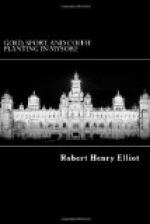the diminution of weight is of course of immense advantage.
Messrs. Holland and Holland inform me that they have
made many experiments with the 8-bore Paradox against
the 8-bore rifle, and in every case have obtained higher
velocity and greater penetration with the Paradox.
The new 10-bore is almost a 9, and practically is
big enough for any game. It shoots 8 drams of
powder, and a fairly long conical bullet, and its
weight is about 12-1/2 lbs. Messrs. Holland and
Holland have invented a new steel bullet for these
guns, and with this the penetration is very great.
The 20 and 16-bore Paradox guns weigh from 6-1/2 lbs.
to 7 lbs., and are largely used on the Continent for
shooting wild boar, bears, and other large game.
Nearly all these guns are made with hammers, because
as a rule sportsmen travelling in wild countries prefer
to have the old-fashioned hammer guns, which are so
universally understood, instead of a hammerless gun,
which cannot be so easily repaired should it break
down in any part. Messrs. Holland and Holland
inform me that for the ordinary 12-bore Paradox weighing
7 lbs. the usual charge of 3 drams is all that is
necessary for soft-skinned animals such as tigers,
leopards, and bears, but they also make a heavier
12-bore, weighing from 8 lbs. to 8-1/2 lbs., and shooting
4 or 4-1/2 drams of powder, but generally recommend
the usual 7 lbs. Paradox, and, from my experience
of the latter with tigers, I do not think one could
desire a better gun for all jungle shooting, though
I need hardly add that for antelope shooting on the
plains a long range rifle is desirable.
FOOTNOTES:
[21] “Jungle Life in India, or the Journeys
and Journals of an Indian Geologist,” by V.
Ball, M.A. London, Thos. De La Rue and Co.,
1880.
[22] “My Indian Journal,” by Colonel Walter
Campbell. Edinburgh, Edmonston and Douglas, 1864.
[23] In Jerdon’s “Mammals of India”
it is stated that in Nepaul the wild dogs, whose urine
is said to be peculiarly acrid, sprinkle it over bushes
through which an animal will probably move with the
view of blinding their victim. Jerdon certainly
disbelieves the native story of their capturing their
prey through the acridity of their urine. It seems
to me not improbable that the wild dogs may have become
aware of the offensive character of their urine, and
in passing near a tiger might discharge some of it
with the view of annoying the tiger and driving him
away, and also perhaps as a mark of contempt, and
that this probably was the origin of the widely spread
story I have alluded to in the text.
CHAPTER VI.
THE INDIAN BISON.




